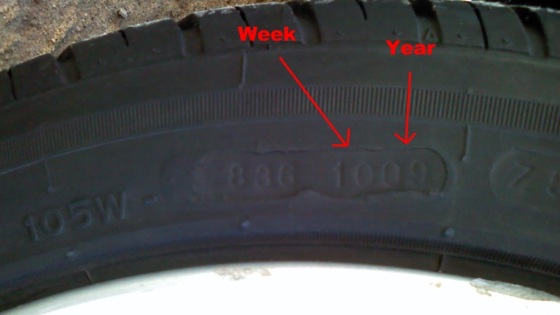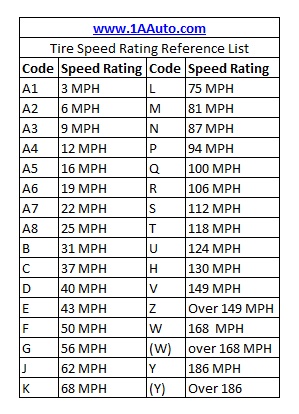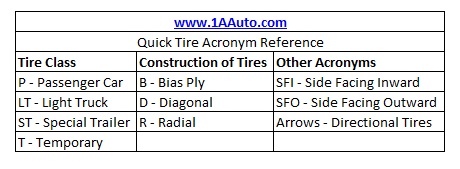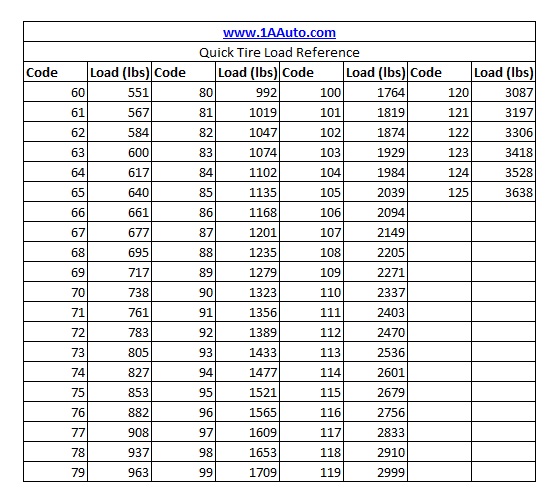Tire Size Guide - What the Letters and Numbers Mean
Jeremy from 1A Auto explains what the letters and numbers on tires mean to help you make educated decisions when purchasing tires. We cover tire sizes, tire age, tire construction, tire speed ratings, tire load ratings, and how to calculate a tire's height and width yourself.

How to Read Tire Age

In the image above, you can see this tire was made during the 10th week of 2009. This is always a fun thing to look at when purchasing "new" tires. As you can imagine, some shelf life is expected, but you don't want to be paying a "new" price for old tires.
Tire Speed Rating Chart

This chart shows the relationship between tire speed rating codes and their mile per hour speed rating. Most tires found on cars rate at typical highway speeds or higher. However, if you take your vehicle to the race track on the weekends, this rating is important to know. As you can imagine, you don't want your Q-rated tire hitting 140mph speeds on the straightaways each weekend.
Tire Class, Construction, and Acronym Chart

This chart shows some common letters and acronyms you may find on the sidewall of your car or truck tire. You will see Tire Class (P, LT, ST, T), Tire Construction (B, D, R), and other common acronyms (SFI, SFO, directional tire arrows).
Tire Load Ratings Chart

This chart shows the load ratings for car, truck, and trailer tires. Keep in mind these load ratings are for one tire. So, assuming your vehicle has four tires, you can multiple the load rating by four, and hope that your vehicle weighs less than that. Naturally, overloading your tires is really dangerous. It does not take long for an overloaded tire to violently remove itself from the situation.

How to Calculate Tire Width and Height in Inches
To figure out how wide a tire is in inches, multiply the width by the number .03937.
Example Tire Size: 235/45/17
235 x .03937 = 9.25 inches wide (This is the width at the widest. Usually the tread itself is slightly less, because the tire "balloons" slightly at the sidewalls.)
To figure out the overall height of a tire in inches, do the math below.
Example Tire Size: 235/45/17
235 x .45 = 105.75 (That's the total height of the sidewall in millimeters. Now we need to convert it to inches.)
105.75 x .03937 = 4.16 inches
Now since the diameter of the entire tire includes two sidewalls and a wheel diameter, we have to add them all up...
17 + 4.16 + 4.16 = 25.32 inches
Transcription:
"Hey, I'm Jeremy from 1A Auto, and this is a tire. Today I'm going to teach you about what all the numbers and letters on the side mean.
One of the cool things about tires is that the side of the tire actually tells you everything about the tire. One of the things that I find really interesting is that the tire actually tells you how old it is. It tells you the month it was made and the year it was made. This is really interesting if you're buying a used set of tires from a junkyard, or Craigslist, or eBay, or something like that. Even if you're just buying them brand new at a store, you can find out how old the tire actually is, because sometimes you buy a brand new tire but you find out the tire is actually a couple of years old. You've always got to watch out for that at any place that you're getting a really good deal on tires. It may be an old tire.
The way that you figure this out is, on the side of the tire, there's an oval with some numbers in it. If the tire was made before the year 2000, it's a three-digit number. It'll be the week of the year that it was made and then the year that it was made. In this case it would be the 16th week of the seventh year. This could actually mean 1987 or 1997. In 2000, the number was actually standardized because tires were getting confused between decades. Tire manufacturers started using four-digit codes. Now it's the 16th week of the seventh year and you can tell it's 2007. There's no longer any confusion of 1987 or '97. It's 2007 because it's 07. This, again, is really useful if you're buying a used set of tires. I've used it a bunch of times and I've often been shocked at what I've found.
On an actual tire, you can see the number right here. You can see it says 1607. If this was made in 2009, it would say the week it was made, in this case 16, and then it would say 09 instead of 07. If it was a different week of the year, it could say maybe 32 of 07. It's always the first two digits are the week and the second two digits are the year.
One of the most important things about a tire is the tire size. In this case we have 235/45/17. Two-thirty-five is the amount of millimeters wide the tire is. The more millimeters, the wider the tire. The less millimeters, the thinner the tire. Forty-five is the height of the sidewall. In this case it's 45 percent of 235. This is always a percentage of the width. Seventeen is the diameter of the wheel itself. In this case it's a 17-inch wheel. We have a 235 wide; 45 percent of 235 is the height of the sidewall, on a 17-inch wheel.
On the tire itself, you can see the size of the tire right here: 235 millimeters; 45 percent of 235 is the height of the sidewall. "R" actually stands for radial; it's a radial tire. Pretty much all tires these days are radials, and 17 is the diameter of the wheel. 235/45/R17.
Another really important factor about tires is the load rating, the speed rating and the type of tire that it is. Today we have a 94Q M+S. That's what the side of the tire says. Ninety-four is the load rating. That means it can handle 1,477 pounds all on that one tire. You multiply that times four and hopefully your car weighs less than that. If it weighs more than that, you're overloading your tires and it's unsafe. "Q" is the speed rating. That means these tires can go 100 miles an hour safely. The higher the letter, the faster that you can go. You'll see something like a Corvette might have a Z-rated tire on it. Obviously this is pretty important if you ever take your car to the racetrack or anything like that. You want to make sure your tires are safe to go the speed that you're going to be going. "M and S". That is mud and snow. That's what most tires are. If you go look at your car right now, it probably has an "M + S" on the side of it. It's pretty much a good all-season tire. You can buy strictly winter tires or strictly summer tires or strictly race tires, but M + S is the pretty standard all season tire.
Right here next to the tire size, you get your 235/45/R17, you can see there's an 94Q M+S. That's the "94" load rating of 1,477 pounds. The "Q" is the speed rating of 100 miles an hour and then mud and snow. It's basically an all season tire.
On the side of the tire, you'll find a max inflation pressure. This is not what you set your tire pressures to. This is the maximum amount of pressure that the tire can handle without exploding, or at least becoming dangerous. In our case, it is a max inflation pressure of 44 PSI. That's actually what a lot of tires are. Once again, that is not what you set your tires to. That is the maximum that they can handle as far as pressure goes. You always want to follow the instructions on your door. In the doorjamb it usually says the recommended tire pressure for your car. Every car is different. It's usually between 28 PSI and 36 PSI, sometimes higher, sometimes lower. Heavy trucks have very different tire pressures, so you always want to be careful with those. The same with trailers. Those have very different tire pressures as well. Once again, the max tire pressure is not something that you want to put in your tire. It's just the maximum that the tire can handle.
Right here, you'll see the max inflation pressure of 44 PSI. Once again, that's not what you want to inflate your tires to. That is just the maximum pressure that tire can handle before it gets dangerous.
The last thing worth mentioning as far as tires go is the sidewall of the tire. The sidewall right here is this 45 number, as you can see. It's also the most important part of a run-flat tire. If you have one of the newer cars that has run-flat tires, this section of the tire is actually thicker. It allows it to be driven while flat. Even though there's no air pressure in it, you can still drive it to the nearest gas station or a shop to get it repaired or at least put some air in it. A normal tire like this one, as soon as it gets flat, the sidewall actually compresses and the sidewall will actually start breaking up as you're driving. Eventually the tread separates from the bead and the tire will come off the rim and then you destroy your wheel. Obviously, that's not the best situation.
One last thing worth mentioning about tires today, is the different sections of the tire. This inside section right here, is the "bead" of the tire. Within this is actually a metal cable. That holds the tire tight against the rim. A really common problem with aluminum wheels is corrosion builds up on the inside of the aluminum wheels and it actually creates a gap between this rubber seal and the wheel. Air will leak out and eventually your tire will be flat.
That's about it for tires today. Hopefully you learned something. If nothing else, you can go outside and see how old your tires are.
Once again, don't forget to visit 1aauto.com. Thanks for watching."

Customer Feedback

"Thanks for the fast reliable service. Great price, and the headlights were as good as oem or better!!! Keep up the good work..."- Dwuan M.
Read More
